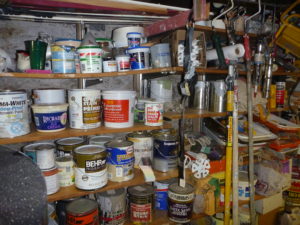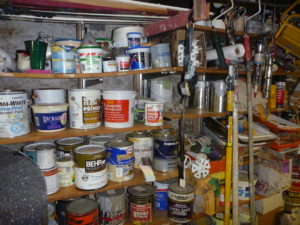Volatile Organic Compounds (VOC) in paint are the solvents that get released into the air as the paint dries. These solvents are many in number and are both man-made and naturally occurring. Most of the strong odors from paint are of VOC. Typical occurring some of the solvents released from paint are aliphatic acetone, hydrocarbons, formaldehyde, ethyl acetate and glycol ethers.
What Constitutes LOW VOC Paint?

Many paint manufacturers are now claiming to make eco-friendly paint, however many of these claims are questionable. According to the EPA (United States Environmental Protection Agency), a flat or latex VOC paint should contain no more than 250 grams per liter (g/l,) and oil-based paints no more than 380 per liter (g/l). Furthermore, to qualify as VOC-free the paint should have no more than 5 (g/l) of VOC per liter. However, in some states the allowed amounts are even more stringent. And some paint industries motivated by environmental concerns and because of more stringent regulations are leaning towards using more aqueous solvents in their paints.
It is estimated that the VOC from traditional paints is responsible for 10% of the ozone’s depleting substances in the USA. And it is not too good for your health either. Although the level of VOC will vary from company to company, whatever the level VOC can cause you instant harm, including breathing irritation, eye problems, dizziness, headaches, and possible memory problems. Studies have even shown that using paints containing VOC can cause asthma and cancer. Pregnant women are especially sensitive to VOC and too much exposure to it has been known to result in birth defects and even miscarriage. Children should also avoid VOC at all costs because exposing their developing lungs to it can cause asthma.
While there are many things you can do to decrease the negative effects of VOC. The best thing to do is avoid paints with VOC altogether and choose VOC-free paint instead. By using VOC free paint, you will be protecting your health and helping the environment.
Green Seal
Green Seal’s April 2006 “Proposed Environmental Standard and Environmental Evaluation of Recycled Content Latex Paint” states the following related to the continued release of VOCs from latex paints:
“Although many of the toxic materials found in paints have been reduced in recent years due to legislation, especially among latex paints, some may still be released as the paint dries and the compounds volatilize, while others continue to be released into the ambient environment after the paint dries when there is no detectable odor…Paint emissions can continue for extended periods of time after application and Sparks et al. (1999) estimated that less than 50% of the VOC’s in latex paint (applied to a surface) are emitted in the first year. Compounds studied include ethylene glycol, propylene glycol, Texanol®, and butoxyethanol.”
First of all, there is no clear mandatory standard for what constitutes a Low-VOC paint or a Zero-VOC paint. Even the voluntary standards that do exist do not include VOCs from the pigment added at the paint store when you tint the paint at purchase. Also, please be aware that just like a lot of other “organic” marketing going on with our milk and foods, some companies use Low-VOC or No-VOC paint as a marketing term. Further, because these terms are confusing, a lot of store clerks may improperly inform you as to the actual VOC status of a paint. It will ultimately be up to you to read the labels on the paint can and see if they at least meet the Green Seal GS-11 Standard or better.
Low Odor Paint
Low Odor or Low VOC Paint are terms used to describe VOC content that meets the less stringent EPA standard of 250 g/L for latex paints or 380 g/L for oil-based paint. But here’s where it gets confusing. A paint may be labelled Low VOC and be significantly BETTER than these standards. For example, if you buy a Green Seal certified paint, the maximum VOC content will be 50 g/L for flat paint or 150 g/L for other paint, not 250 g/L as per the EPA standard.
So Low Odor or Low VOC paints are generally marketed by reputable paint manufacturers as at least meeting the 50 g/L VOC threshold. You should look for a VOC range of 10-25 g/L.
An example of a paint that meets this spec is Pristine Eco-Spec Paint by Benjamin Moore & Co. (www.benjaminmoore.com)
Zero VOC Paint
Zero VOC or NO VOC paint really means very, very low levels of VOC. Usually paints marketed with these titles will have VOCs in the range of under 5 g/L. Even when adding in pigment at the paint store which can add 2-5 g/L of VOC. The total VOC content for the mixed paint should be under 10 g/L which is very good.
This low level of VOC content paint is as good as it’s going to get with the larger paint companies.
An example of a paint that meets this spec is Harmony® Paint by Sherwin-Williams. (www.sherwin.com)






